Ballasting a Mid-19th Century Chilean Navy Armed Transport: Archaeometallurgical Insights into Cast Iron Ingots Recovered from the Barque Infatigable (1855)
Abstract
1. Introduction
1.1. Infatigable: A Chilean Navy Armed Sailing Transport
1.2. Historical Remarks on Ballast and Ballasting of Vessels in the Modern Period
2. Research Background
2.1. Kentledge or Pig Iron Ballast
2.2. A Brief Definition of Cast Iron
3. Materials and Methods
3.1. Iron Ballast Samples
3.2. Microstructural Characterisation and Chemical Analyses
4. Results
4.1. Macroscopic Study
4.2. Microstructural and Chemical Features
5. Discussion
6. Conclusions
Author Contributions
Funding
Institutional Review Board Statement
Informed Consent Statement
Data Availability Statement
Acknowledgments
Conflicts of Interest
References
- Gifford, M.J. Everything Is Ballast: An Examination of Ballast Related Practices and Ballast Stones from the Emanuel Point Shipwrecks. Unpublished Master’s Thesis, The University of West Florida, Pensacola, FL, USA, 2014. Available online: https://www.academia.edu/8244906/Everything_is_Ballast_An_Examination_of_Ballast_Related_Practices_and_Ballast_from_the_Emanuel_Point_Shipwrecks (accessed on 30 September 2022).
- Keith, D.H.; Simmons, J.J. Analysis of hull remains, ballast, and artifact distribution of a 16th-century shipwreck, Molasses Reef, British West Indies. J. Field Archaeol. 1985, 12, 411–424. [Google Scholar] [CrossRef]
- Herrera, J.M. Ballast in the Port of Veracruz during the Second Half of the Eighteenth Century. In Underwater Archaeology; Lakey, D.A., Ed.; Society for Historical Archaeology: Uniontown, PA, USA, 1997; pp. 22–26. [Google Scholar]
- Villegas, T. El lastre en las naves europeas destinadas a América durante los siglos XVI y XVII. In Memorias del Congreso Científico de Arqueología Subacuática ICOMOS.; Erreguerena, P.L., Roffiel, R., Eds.; Instituto Nacional de Antropología e Historia: Mexico City, Mexico, 2001; pp. 131–142. [Google Scholar]
- Murray, C.; Vainstub, D.; Manders, M.; Bastida, R. El naufragio del Hoorn-1615-Prospecciones costeras y subacuáticas en la Ría Deseado (Santa Cruz-Argentina). In Arqueología de Fuego-Patagonia. Levantando Piedras, Desenterrando Huesos… y Develando Arcanos; Morello, F., Prieto, A., Martinic, M., Bahamondes, G., Eds.; Ediciones CEQUA: Punta Arenas, Chile, 2007; pp. 351–355. [Google Scholar]
- L’Hour, M.; Veyrat, E. A mid-15th century clinker boat off the north coast of France, the Aber Wrac’h I wreck: A preliminary report. Int. J. Naut. Archaeol. Underw. Explor. 1989, 18, 285–298. [Google Scholar] [CrossRef]
- Ciarlo, N.C.; Carrillo Márquez, L.; López Martín, S.J.; Zuccolotto Villalobos, A.; Guzmán Torres, J.; Pérez Morales, E.; Brown, R.R.; López Garrido, P.H. Revisitando el sitio 40 Cañones: Investigación arqueológica y documental de un naufragio del siglo XVII, Banco Chinchorro, México. In I Congreso Iberoamericano de Arqueología Náutica y Subacuática; University of Cadiz: Cadiz, Spain, 2022; in press. [Google Scholar]
- Garrison, E.G.; Giammona, C.P.; Jobling, J.; Tripp, A.R.; Weinstein, E.N.; Wolff, G.A. An Eighteenth-Century Ballast Pile Site, Chandeleur Islands, Louisiana. An Instrumental and Archaeological Study; OCS Study/MMS 89-0092; U.S. Department of the Interior, Minerals Management Service, Gulf of Mexico OCS Regional Office: New Orleans, LA, USA, 1989. Available online: https://espis.boem.gov/final%20reports/3689.pdf (accessed on 30 September 2022).
- L’Hour, M.; Veyrat, E. Un Corsaire Sous la Mer. Les Epaves de la Natière, Archéologie Sous-Marine à Saint-Malo; Edition Adramar: Saint-Malo, France, 2002. [Google Scholar]
- Lamb, W.R. The Provenance of the Stone Ballast from the Molasses Reef Wreck. Unpublished Master’s Thesis, Texas A&M University, College Station, TX, USA, 1988. Available online: https://nautarch.tamu.edu/Theses/pdf-files/Lamb-MA1988.pdf (accessed on 30 September 2022).
- Guérout, M.; Rieth, E.; Gassend, J.-M.; Liou, B. Le navire Génois de Villefranche, un naufrage de 1516? Archaeonautica 1989, 9, 5–171. [Google Scholar] [CrossRef]
- Van Duivenvoorde, W.; Stedman, J.; Billström, K.; Stos-Gale, Z.A.; McCarthy, M. The Lead Ingots from the Wreck of the Zuiddorp (1712), Western Australia: A report on their provenance and manufacture. Int. J. Naut. Archaeol. 2013, 42, 150–166. [Google Scholar] [CrossRef]
- Brandl, M.; Martinez, M.M.; Hauzenberger, C.; Filzmoser, P.; Nymoen, P.; Mehler, N. A multi-technique analytical approach to sourcing Scandinavian flint: Provenance of ballast flint from the shipwreck “Leirvigen 1”, Norway. PLoS ONE 2018, 13, e0200647. [Google Scholar] [CrossRef]
- Weissel, M.; Garberoglio, R.M.; Padula, H. Corals Used as Ballast: The Zen City Site, an 18th Century Shipwreck Found at Buenos Aires City, Argentina. 2021. Available online: http://socarchsci.blogspot.com/2021/08/corals-used-as-ballast-zen-city-site.html (accessed on 30 September 2022).
- Carabias, D. Valparaíso. El Patrimonio Bajo la Cota Cero del Puerto Principal. Revista Cultura y Desarrollo 13, 34-39. Patrimonio Cultural Subacuático en América Latina y El Caribe; UNESCO, Oficina Regional de Cultura para América Latina y el Caribe: La Habana, Cube, 2015. [Google Scholar]
- Carabias, D.; Simonetti, R.; Morales, C. Exploring Infatigable (1855): First Insights from Archaeology into the Mid-Nineteenth Century Chilean Navy; Society for Historical Archaeology Conference: New Orleans, LA, USA, 2018. [Google Scholar]
- Falconer, W. An Universal Dictionary of the Marine; T. Cadell: London, UK, 1780. [Google Scholar]
- Moore, L.L. The British Mariner’s Vocabulary; J. Cundee: London, UK, 1801. [Google Scholar]
- Steel, D. The Shipwright’s Vade-Mecum: A Clear and Familiar Introduction to the Principles and Practice of Ship-Building; P. Steel: London, UK, 1805. [Google Scholar]
- Meade, R.W. A Treatise on Naval Architecture and Ship-Building; J.B. Lippincott & Co.: Philadelphia, PA, USA, 1869. [Google Scholar]
- O’Scanlan, T. Diccionario Marítimo Español; Imprenta Real: Madrid, Spain, 1831. [Google Scholar]
- De Lorenzo, J.; De Murga, G.; Ferreiro, M. Diccionario Marítimo Español; Establecimiento Tipográfico de T. Fortanet: Madrid, Spain, 1854. [Google Scholar]
- Falconer, W.; Burney, W. A New Universal Dictionary of the Marine; Cadell and Davies: London, UK, 1815. [Google Scholar]
- O’Scanlan, T. Cartilla Práctica de Construcción Naval; Don Miguel de Burgos: Madrid, Spain, 1829. [Google Scholar]
- Feaser, E. HMS “VICTORY.” (Continued). Mar. Mirror 1922, 8, 259–264. [Google Scholar] [CrossRef]
- Harvey, A.D. Collision of Empires: Britain in Three World Wars, 1793–1945; Hambledon Press: London, UK, 1922. [Google Scholar]
- Henderson, G.; Klaka, K. Who or what sank HMS Sirius at Norfolk Island in 1790? Aust. Nav. Archit. 2019, 23, 38–39. [Google Scholar]
- Herrera, J.M.; Jiménez, P.; Pacheco Ruiz, R.; Blancas, J.; Ortiz Butrón, A.; Barba, L.; Vega Sánchez, R.; Arenas Cruz, M.; Mata, D.; Castillo Pérez, E.; et al. La memoria anfibia: Arqueología marítima de la Guerra entre México y los Estados Unidos, 1846–1848. In Arqueología en Campos de Batalla. América Latina en Perspectiva; Landa, C., Hernández de Lara, O., Eds.; Aspha: Buenos Aires, Argentina, 2020; pp. 63–116. [Google Scholar]
- Borrell, P.; Pérez Montás, E.; Apestegui, C. La Aventura del Guadalupe. Su viaje a La Española y su hundimiento en la Bahía de Samaná; Comisión de Rescate Arqueológico Submarino, CRAS: Lunwerg, Dominican Republic, 1997. [Google Scholar]
- Izaguirre, M. Pecios y materiales diversos de la bahía de La Concha (San Sebastián). In La Memoria Sumergida. Arqueología y Patrimonio Subacuático Vasco; Unsain, J.M., Ed.; Museo Naval: Donostia-San Sebastián, Spain, 2004; pp. 91–105. [Google Scholar]
- Maarleveld, T.; Overmeer, A.; Brinkkemper, O.; van Deijk, F.; Gijsbers, W.M.; Jacobs, E.M.; Joosten, C.; Terhorst, M.; Vos, A.D. Aanloop Molengat—Maritime archaeology and intermediate trade during the Thirty Years’ War. J. Archaeol. Low Ctries. 2012, 4, 95–149. [Google Scholar]
- Birch, T.; Charlton, M.F.; Biggs, L.; Stos-Gale, Z.A.; Martinón-Torres, M. The Cargo. In The Gresham Ship Project A 16th-Century Merchantman Wrecked in the Princes Channel, Thames Estuary; Milne, G., Sully, D., Eds.; British Archaeological Reports, British Series No. 606; Archaeopress: Oxford, UK, 2014; Volume 2, pp. 53–69. [Google Scholar]
- Green, J. The wreck of the Dutch East Indiaman the Vergulde Draeck, 1656. Int. J. Naut. Archaeol. Underw. Explor. 1973, 2, 267–289. [Google Scholar] [CrossRef]
- McGrail, S. The Shipment of Traded Goods and of Ballast in Antiquity. Oxf. J. Archaeol. 1989, 8, 353–358. [Google Scholar] [CrossRef]
- King, P.W. Pig iron ballast for the Georgian Navy and its producers. Mar. Mirror 1985, 81, 15–20. [Google Scholar] [CrossRef]
- Lavery, B. The Arming and Fitting of English Ships of War 1600−1815; Conway Maritime Press: London, UK, 1987. [Google Scholar]
- Steel, D. The Elements and Practice of Rigging And Seamanship; D. Steel: London, UK, 1794; Available online: https://maritime.org/doc/steel/ (accessed on 30 September 2022).
- Martínez de Espinosa y Tacón, J.J. Diccionario Marino Inglés-Español para el Uso del Colegio Naval; Imprenta de J. Martín Alegría: Madrid, Spain, 1849. [Google Scholar]
- Ciscar, F. Reflexiones Sobre las Máquinas y Maniobras Del uso de a Bordo; Imprenta Real: Madrid, Spain, 1791. [Google Scholar]
- González-Aller Hierro, J.I. La pérdida de la fragata Mercedes. In El último Viaje de la Fragata Mercedes. La Razón Frente al Expolio. Un Tesoro Cultural Recuperado; Museo Naval & Museo Arqueológico Nacional: Madrid, Spain, 2014; pp. 325–335. Available online: https://www.accioncultural.es/media/Default%20Files/activ/2015/pub/fragataMercedes/El-ultimo-viaje-de-la-Fragata-Mercedes.pdf (accessed on 30 September 2022).
- Brady, W. The Naval Apprentice’s Kedge Anchor; or Young Sailor’s Assistant; Taylor and Clement: New York, NY, USA, 1841. [Google Scholar]
- National Oceanic and Atmospheric Administration—NOAA (1980). Final environmental impact statement prepared on the proposed Looe Key National Marine Sanctuary. Charleston, SC: U.S. Department of Commerce, NOAA Office of Coastal Zone Management. Available online: https://repository.library.noaa.gov/view/noaa/1408 (accessed on 30 September 2022).
- Garrison, E.G. Recent Advances in Close Range Photogrammetry for Underwater Historical Archaeology. Hist. Archaeol. 1999, 26, 97–104. [Google Scholar] [CrossRef]
- Skowronek, R.K.; Fischer, G.R. HMS Fowey. Lost and Found. Being the Discovery, Excavation, and Identification of a British Man-of-War Lost off the Cape of Florida in 1748; University Press of Florida: Gainesville, FL, USA, 2019. [Google Scholar]
- Stanbury, M. Appendix 3. Sirius objects for Australian Bicentennial Authority Exhibition. In Australian Bicentennial Authority Project 1987. Expedition Report on the Wreck of HMS Sirius (1970); Department of Maritime Archaeology, Western Australian Maritime Museum, The Australian Bicentennial Authority: Sydney, Australia, 1988; pp. 31–38. [Google Scholar]
- Erskine, N. Reclaiming the Bounty. Archaeology 1999, 52. Available online: https://archive.archaeology.org/9905/etc/bounty.html (accessed on 30 September 2022).
- Flynn, P.E. HMS Pallas: Historical Reconstruction of an 18th-Century Royal Navy Frigate. Unpublished Master’s Thesis, Texas A&M University, College Station, TX, USA, 2006. Available online: https://www.nautarch.tamu.edu/academic/alum.htm (accessed on 30 September 2022).
- National Heritage List. HMS Sirius Shipwreck (file no. 9/00/001/0023). Australian Heritage Database, Department of Sustainability, Environment, Water, Population, and Communities, Government of Australia. 2020. Available online: https://www.dcceew.gov.au/sites/default/files/documents/sirius-final-assessment-report.pdf (accessed on 30 September 2022).
- San Claudio, M. La fragata de guerra Santa María Magdalena, lecciones para la gestión y preservación del Patrimonio Cultural Subacuático español. Proa Mar 2017, 172, 48–52. [Google Scholar]
- Mitchell, J. HMS Sirius Site Inspection Report; Prepared for the Department of Infrastructure, Transport, Regional Development and Communications; Cosmos Archaeology: Norfolk Island, Australia, 2021. Available online: https://kingston.norfolkisland.gov.au/sites/default/files/documents/hms-sirius-site-inspection-report-2020.pdf (accessed on 30 September 2022).
- Tomalin, D.; Simpson, P.; Bingeman, J.P. Excavation versus sustainability in situ: A conclusion on 25 years of archaeological investigations at Goose Rock, a designated historic wreck-site at the Needles, Isle of Wight, England. Int. J. Naut. Archaeol. 2000, 29, 3–42. [Google Scholar] [CrossRef]
- Beltrame, C.; Gaddi, D. Report on the first research campaign on the Napoleonic brick, Mercure, wrecked off Lignano, Udine, Italy in 1812. Int. J. Naut. Archaeol. 2002, 31, 60–73. [Google Scholar] [CrossRef]
- Guibert, J.-S. Results from the first excavation on the Saintes Bay’s Shipwreck, Guadeloupe, FWI. In ACUA Underwater Archaeology Proceedings; Johnston, P.F., Ed.; Advisory Council on Underwater Archaeology, Society for Historical Archaeology: Washington, DC, USA, 2016; pp. 65–70. Available online: https://hal.archives-ouvertes.fr/hal-01443277/document (accessed on 30 September 2022).
- Bingeman, J.M.; Simpson, P.; Tomalin, D. The Wrecks of HM Frigates Assurance (1753) and Pomone (1811); Oxbow Books: Oxford, UK, 2021. [Google Scholar]
- Bousquet, G.; L’Hour, M.; Richez, F. The discovery of an English East Indiaman at Bassas da india, a French atoll in the Indian Ocean: The Sussex (1738). Int. J. Naut. Archaeol. Underw. Explor. 1990, 19, 81–85. [Google Scholar] [CrossRef]
- L’Hour, M.; Richez, F. An 18th century French East Indiaman: The Prince de Conty (1746). Int. J. Naut. Archaeol. Underw. Explor. 1990, 19, 75–79. [Google Scholar] [CrossRef]
- Direction Générale des Patrimoines (DGP). Shipbuilding|The Structure of the Aimable Grenot: Ballast. Ministry of Culture, France. 2022. Available online: https://archeologie.culture.gouv.fr/epaves-corsaires/en/ballast-0 (accessed on 30 September 2022).
- Boshoff, J.J.; Bunch, L.G.; Gardullo, P.; Lubkemann, S.P. From no Return: The 221-Year Journey of the Slave Ship São José, 1794; Smithsonian, National Museum of African American History and Culture: Washington, DC, USA, 2016. [Google Scholar]
- Smith, S.O. The Frolic Archaeological Survey; California Department of Parks and Recreation, Cultural Heritage Division, PAST Foundation Publication: Columbus, OH, USA, 2005. [Google Scholar]
- Green, J. Shipwrecks of the Ningaloo Reef: Maritime Archaeological Projects from 1978–2009; Australian National Centre of Excellence for Maritime Archaeology, Special Publication No. 14; Western Australian Maritime Museum: Fremantle, Australia, 2011. Available online: https://museum.wa.gov.au/maritime-archaeology-db/sites/default/files/no._14_shipwrecks_of_ningaloo_reef.pdf (accessed on 30 September 2022).
- Van Tilburg, H. Historic period ships of the Pacific Ocean. In The Oxford Handbook of Maritime Archaeology; Oxford University Press: New York, NY, USA, 2011; pp. 588–609. [Google Scholar]
- Guérout, M.; Veccella, R.; Carabias, D. Fouille de l’épave du Francisco Álvarez à Mangareva et inventaire du patrimoine archéologique sous-marin de l’archipel des Gambier. Bull. De La Soc. D’études Océanniennes 2002, 292–293, 45–64. [Google Scholar]
- Gainsford, M. The Redemptora. Report. Department of Maritime Archaeology, Western Australian Maritime Museum No. 166. 2003. Available online: https://museum.wa.gov.au/maritime-archaeology-db/sites/default/files/no._166_redemptora_0.pdf (accessed on 30 September 2022).
- Schwalbe, E.A. Civil War and the H.L. Hunley iron Ballast. Ind. Archaeol. Rev. 2019, 41, 100–106. [Google Scholar] [CrossRef]
- Samuels, L.E. The metallography of cast iron relics from the Bark Endeavour. Metallography 1980, 13, 345–355. [Google Scholar] [CrossRef]
- Samuels, L.E. Australia’s Contribution to Archaeometallurgy. Mater. Charact. 1992, 29, 69–109. [Google Scholar] [CrossRef]
- Ciarlo, N.C.; Argüeso, A. Archaeometric and Archaeometallurgical Studies on Historical Shipwrecks: Research Experiences in Argentina. J. Marit. Archaeol. 2019, 14, 127–150. [Google Scholar] [CrossRef]
- Ciarlo, N.C. Historical Shipwrecks, Archaeometry of. In Encyclopedia of Global Archaeology, 2nd ed.; Smith, C., Ed.; Springer: Cham, Switzerland, 2020. [Google Scholar] [CrossRef]
- Ciarlo, N.C. Industrialisation, Warfare, and Science: An archaeological-historical insight into technological changes of mid-18th to early 19th-century European naval ships. Int. J. Naut. Archaeol. 2023. (Accepted for publication). [Google Scholar]
- Verhoeven, J.D. Fundamentos de Metalurgia Física; Editorial Limusa: México City, Mexico, 1987. (Original work published 1975). [Google Scholar]
- Callister, W.D., Jr.; Rethwisch, D.G. Material Science and Engineering. An Introduction, 9th ed.; Wiley: Hoboken, NJ, USA, 2014. (Original work published 1985). [Google Scholar]
- Scott, D.A. Metallography and Microstructure of Ancient and Historic Metals; Getty Conservation Institute in Association with Archetype Books: Marina del Rey, CA, USA, 1991; Available online: http://hdl.handle.net/10020/gci_pubs/metallography_microstructure (accessed on 30 September 2022).
- Baldwyn Rogers, S. An Elementary Treatise on Iron Metallurgy; Simpkin, Marshall, and Co., Stationers’ Hall Court, and The Mining Journal Office: London, UK, 1858. [Google Scholar]
- Bauerman, H. A Treatise on the Metallurgy of Iron; Virtue & Yorston: New York, NY, USA, 1868. [Google Scholar]
- Crookes, W.; Röhrig, E. Practical Treatise on Metallurgy; Longmans, Green, and Co.: London, UK, 1869. [Google Scholar]
- Fairbairn, W. Iron: Its History, Properties, & Processes of Manufacture; Adam and Charles Black: Edinburgh, UK, 1869. [Google Scholar]
- Greenwood, W.H. A Manual of Metallurgy; William Collins, Sons, & Company: London, UK, 1874. [Google Scholar]
- Bethencourt, M.; Hernández, M.A.; Martínez, E.A.; Abreu, C.M. Apuntes sobre la evolución histórica de la metalurgia armamentística española de los siglos XVII a XIX a través de la caracterización de balas de cañón. In IV Congreso Latinoamericano de Conservación y Restauración de Metal; Instituto del Patrimonio Cultural de España and Grupo Español de Conservación: Madrid, Spain, 2013; pp. 391–399. [Google Scholar]
- ASTM E3-11; Standard Guide for Preparation of Metallographic Specimens. ASTM International: Conshohocken, PA, USA, 2017. [CrossRef]
- ASTM E1508-12; Standard Guide for Quantitative Analysis by Energy-Dispersive Spectroscopy. ASTM International: Conshohocken, PA, USA, 2013. [CrossRef]
- ASTM E1621-13; Standard Guide for Elemental Analysis by Wavelength Dispersive X-Ray Fluorescence Spectrometry. ASTM International: Conshohocken, PA, USA, 2013. [CrossRef]
- ASTM E1019-11; Standard Test Methods for Determination of Carbon, Sulfur, Nitrogen, and Oxygen in Steel, Iron, Nickel, and Cobalt Alloys by Various Combustion and Fusion Techniques. ASTM International: Conshohocken, PA, USA, 2011. [CrossRef]
- Boyd, J.M. A Manual for Naval Cadets; Longmans, & Roberts: London, UK, 1857. [Google Scholar]
- Stevens, R.W. On the Stowage of Ships and Their Cargoes; Longman’s: London, UK, 1858. [Google Scholar]
- Totten, B.J. Naval Text-Book and Dictionary for the Use of the Midshipmen of the U.S. Navy; Van Nostrand: New York, NY, USA, 1862. [Google Scholar]
- Carabias, D.; Simonetti, R. Intrasite Spatial Analysis in Shipwreck Maritime Archaeology: The Infatigable Case Study, Valparaiso, Chile; International Congress of Underwater Archaeology: Helsinki, Finland, 2022. [Google Scholar]
- Föll, H. Kinds of Cast Iron. Kiel: Christian-Albrechts-Universität zu Kiel. 2022. Available online: https://www.tf.uni-kiel.de/matwis/amat/iss/index.html (accessed on 30 September 2022).
- Wiltzen, T.S.; Wayman, M.L. Steel files as chronological markers in North American fur trade sites. Archaeometry 1999, 41, 117–135. [Google Scholar] [CrossRef]
- Turner, T. The Metallurgy of Iron and Steel: Being One of A Series of Treatises on Metallurgy Written by Associates of the Royal School of Mines; Charles Griffin and Company, Ltd.: London, UK, 1895. [Google Scholar]

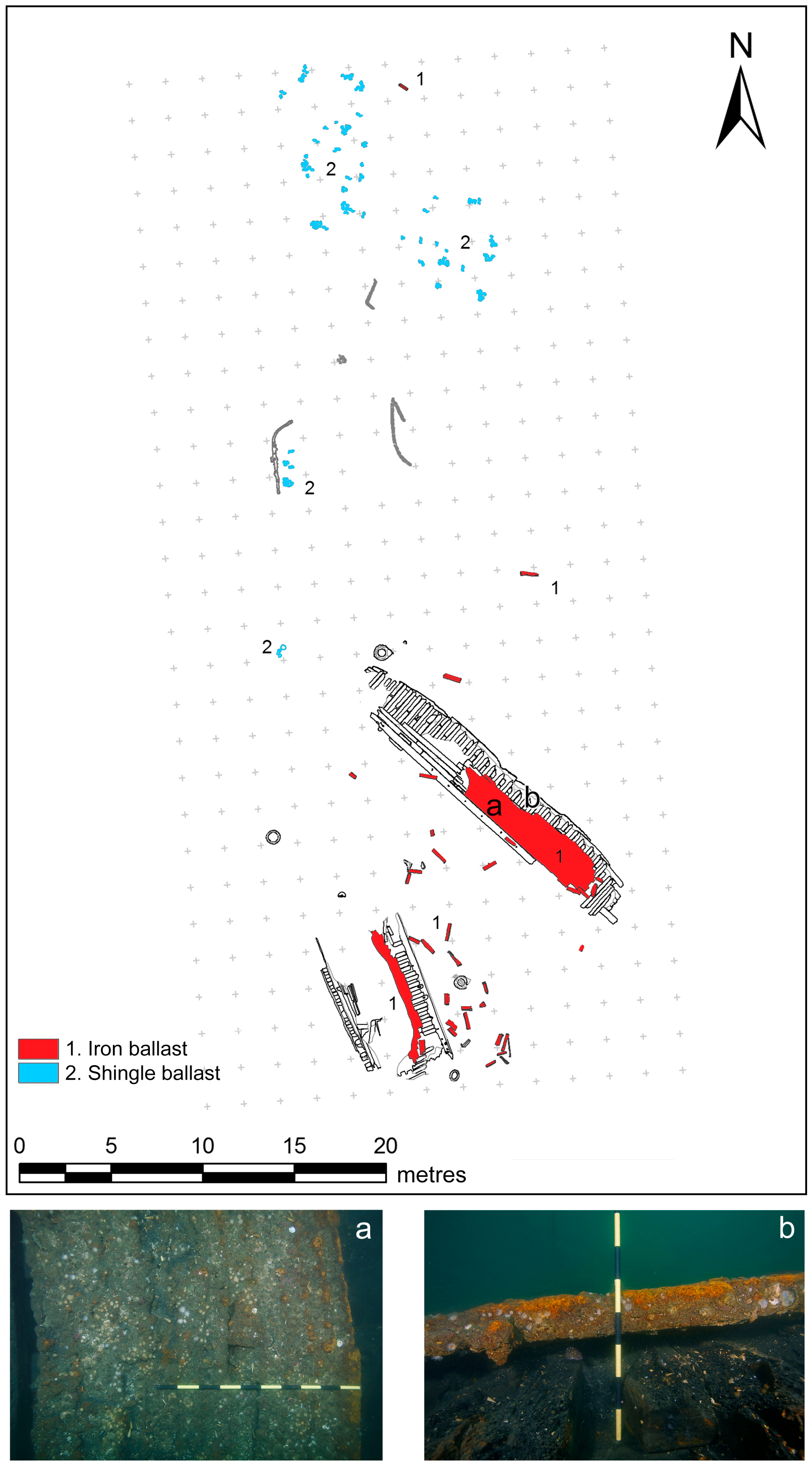

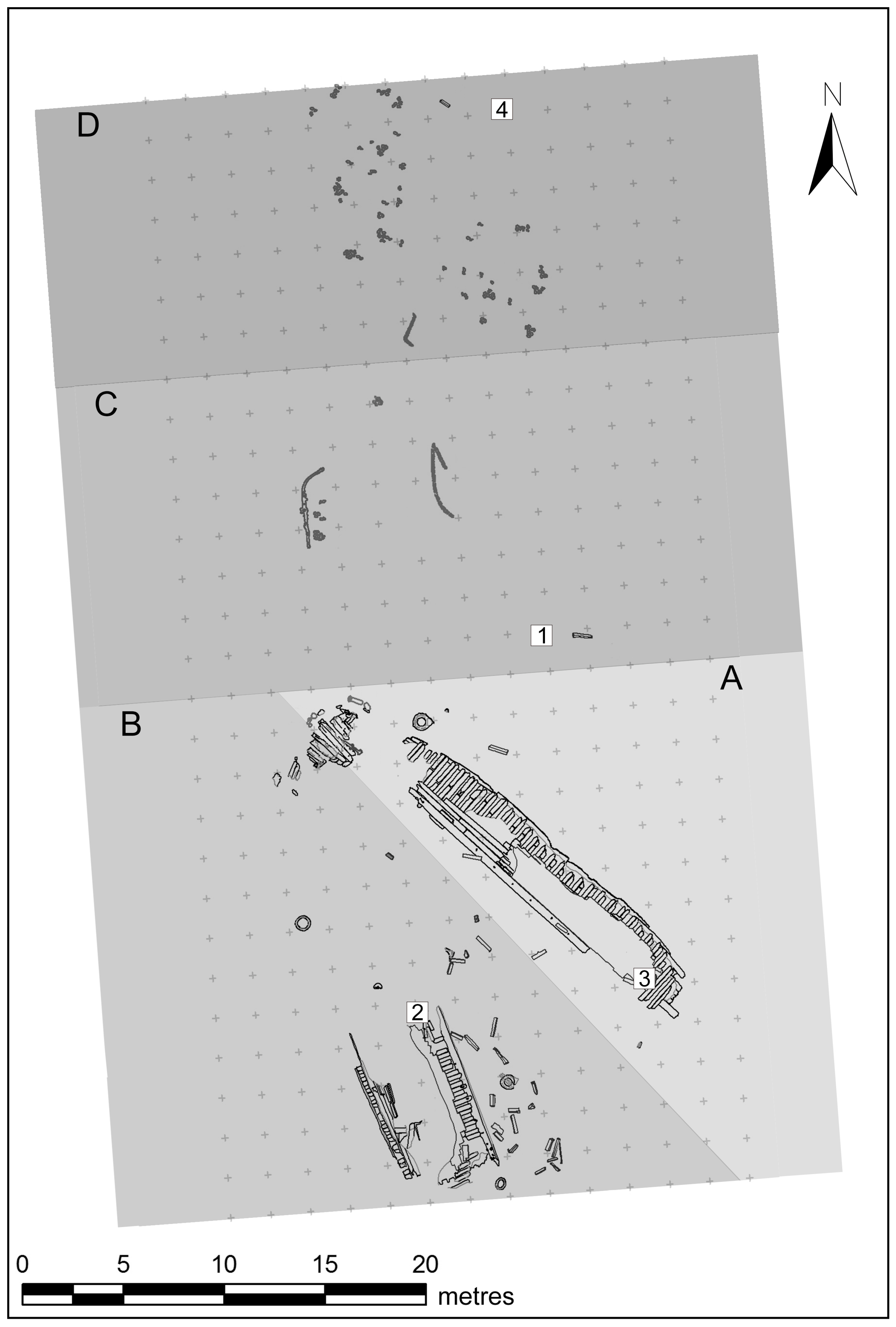
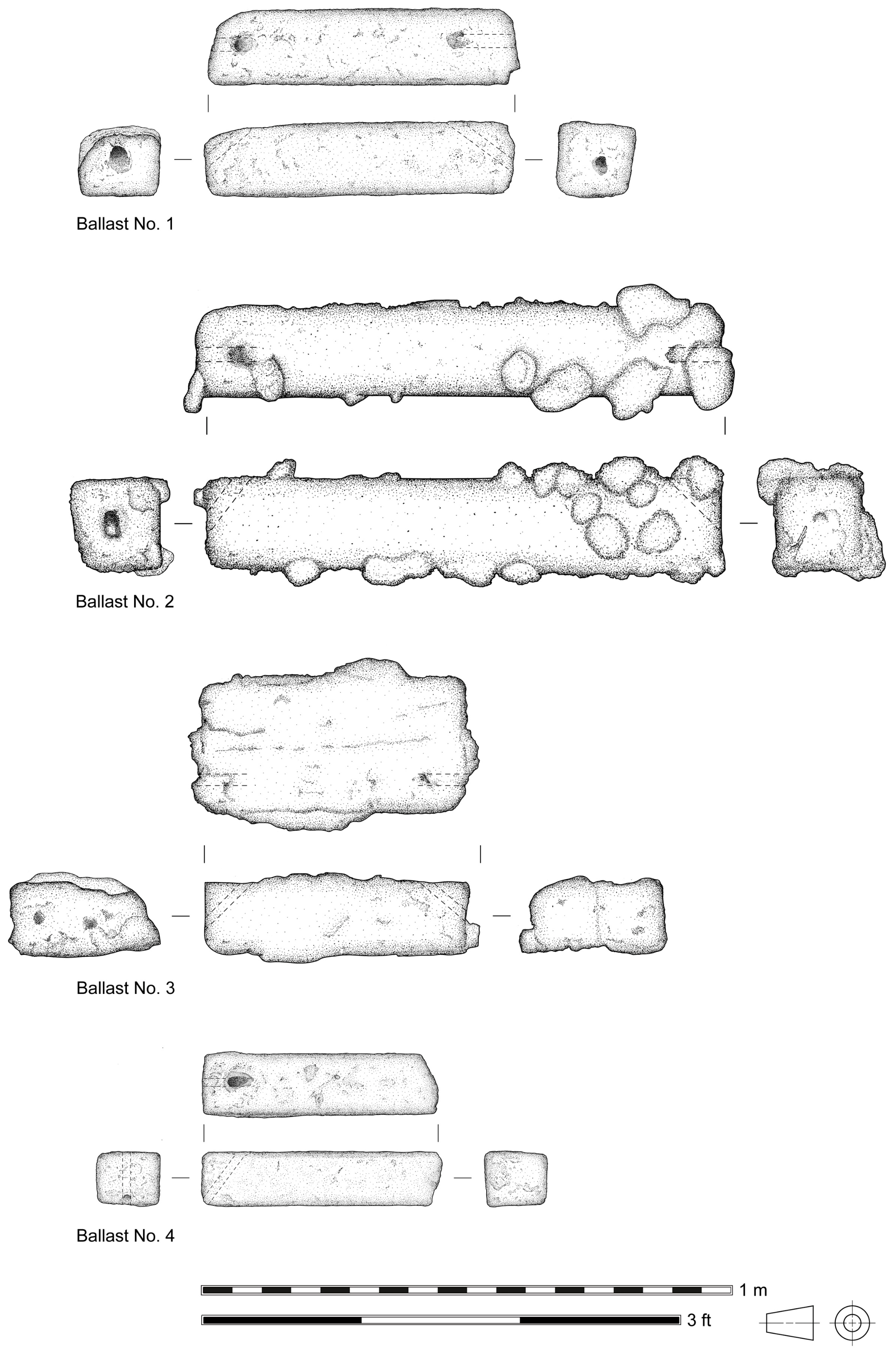
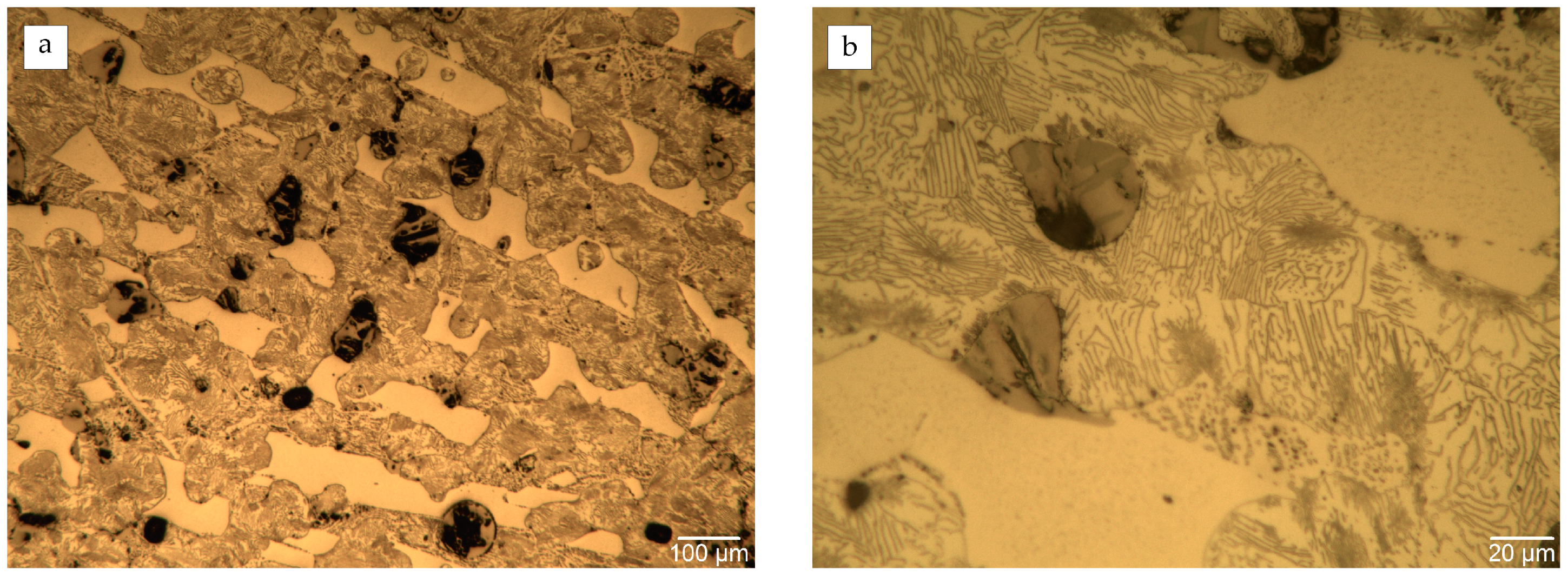

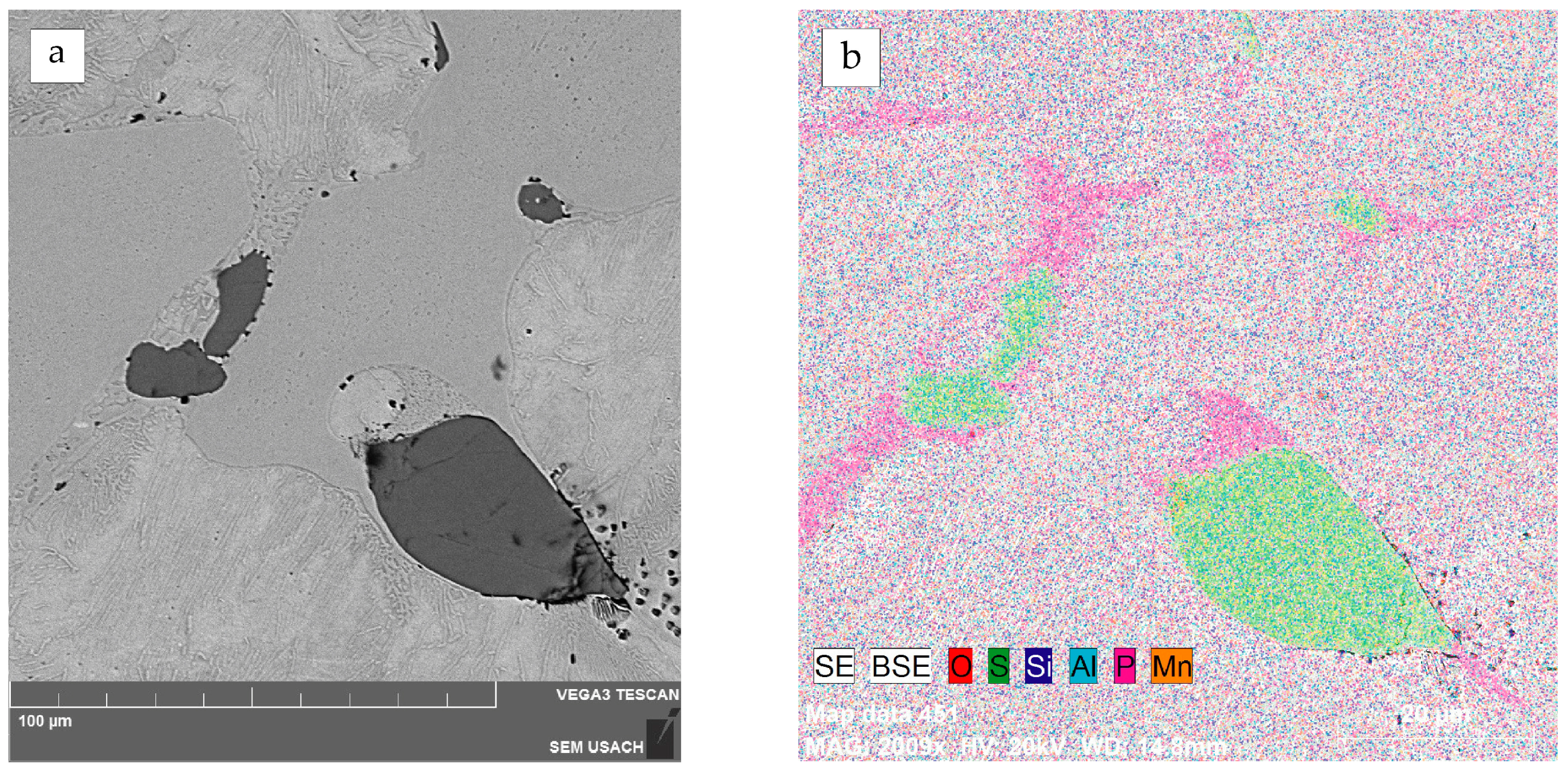
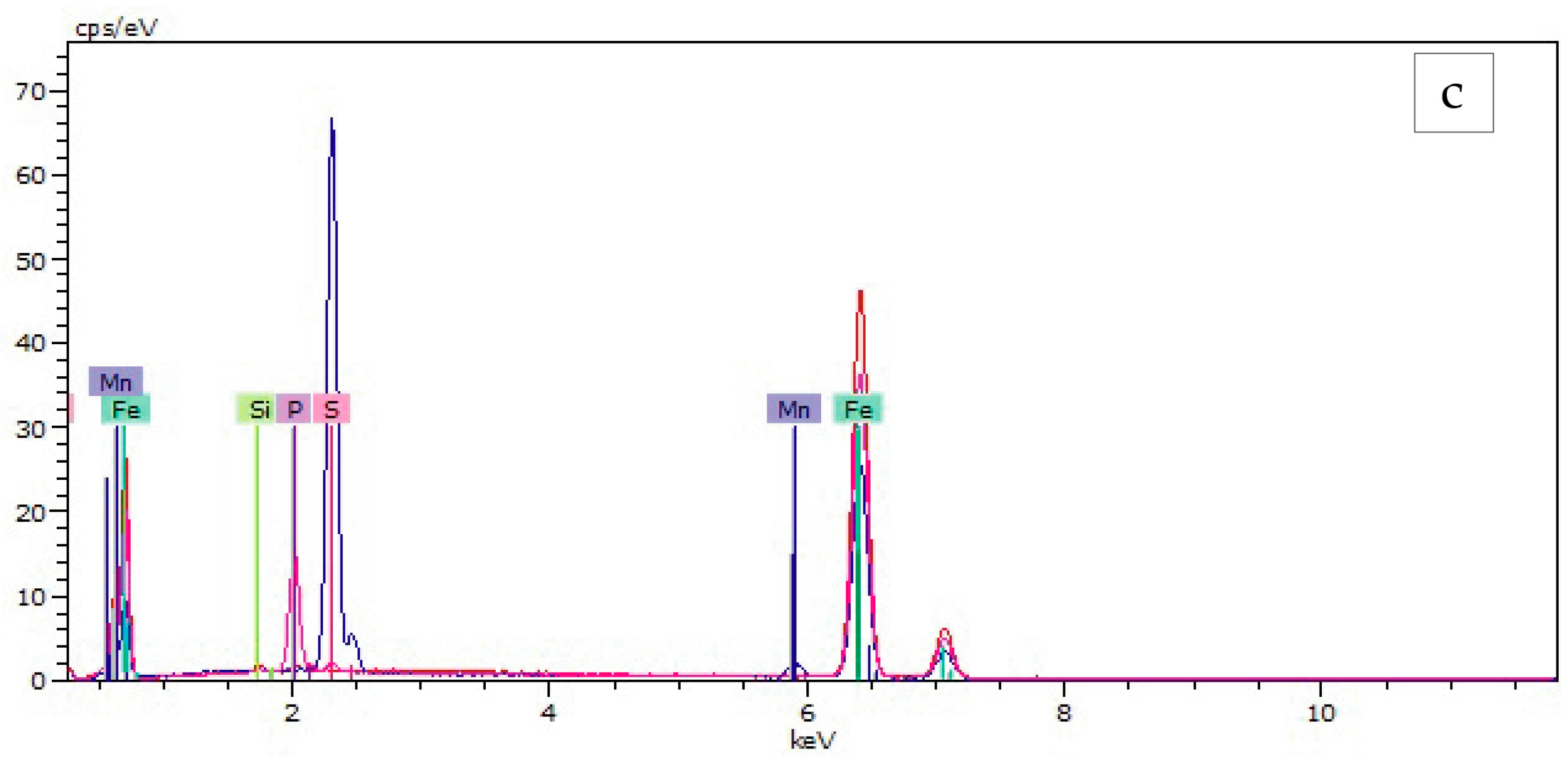
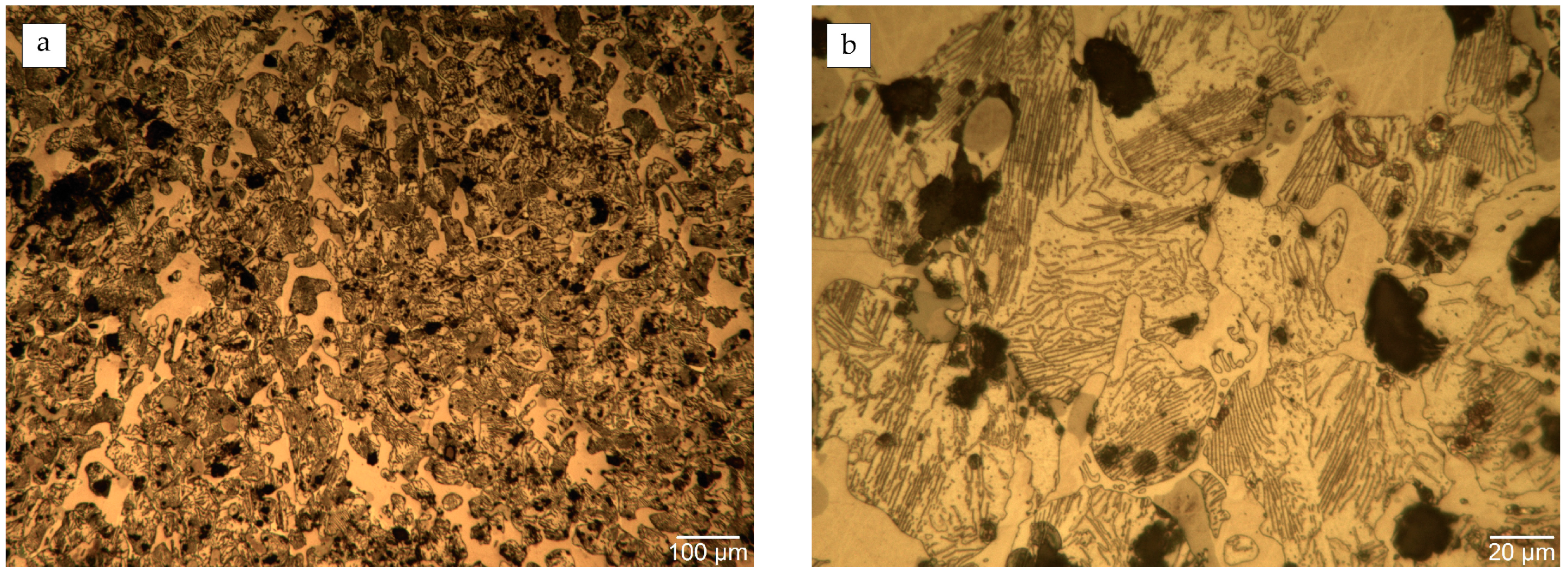
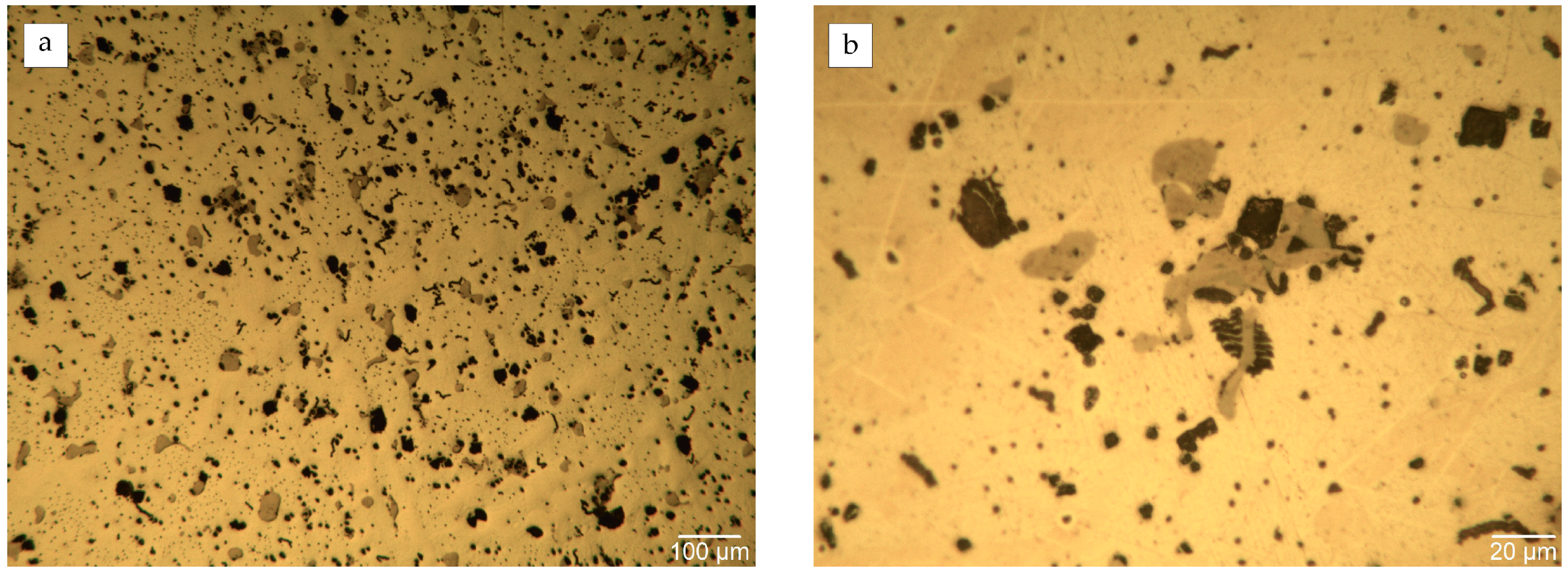

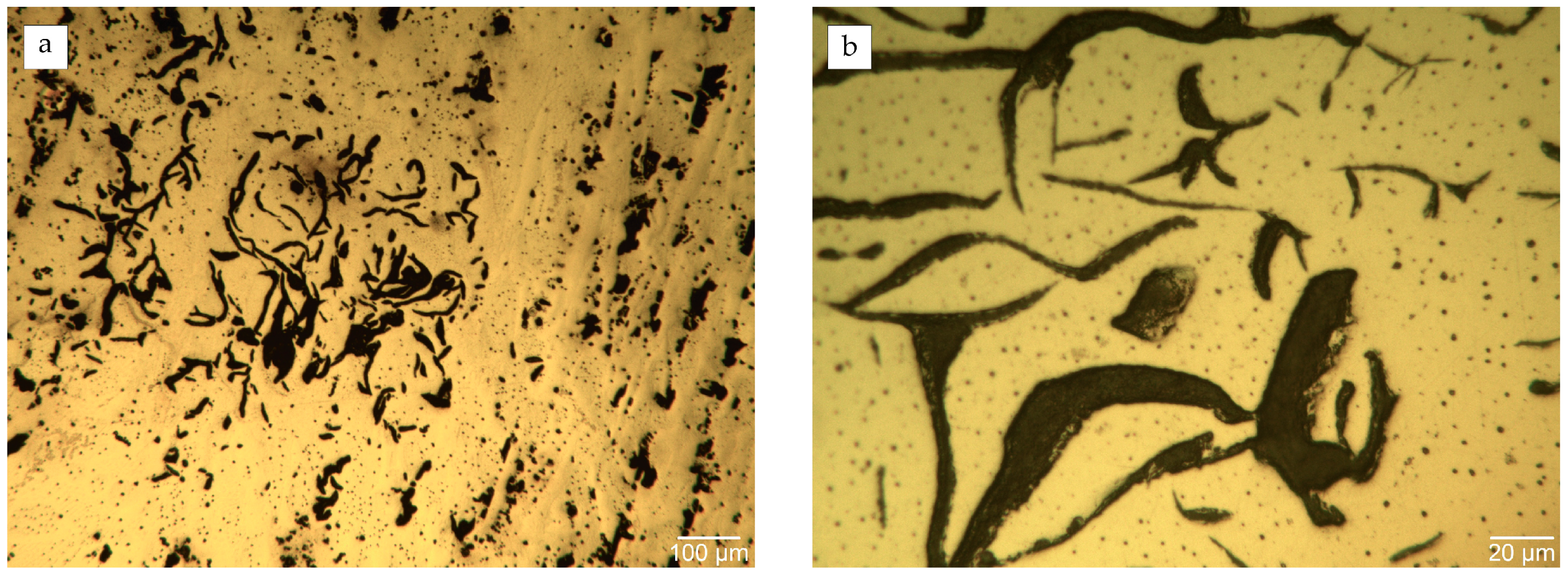



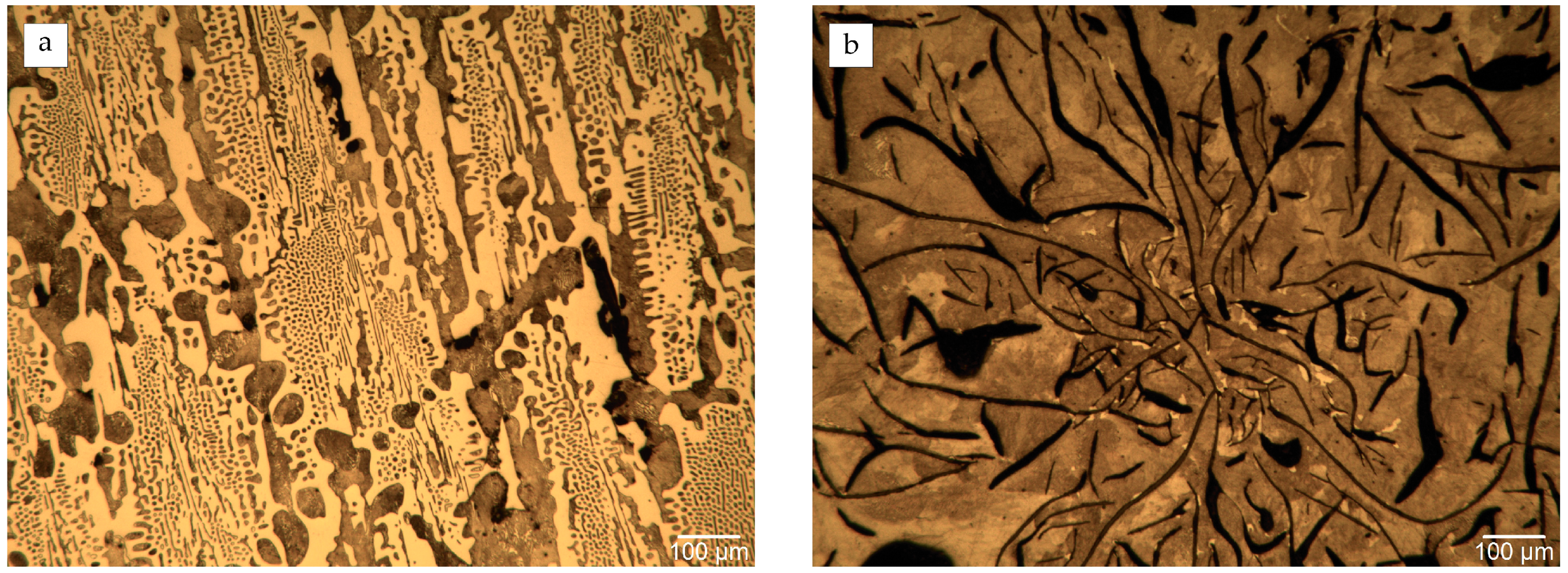

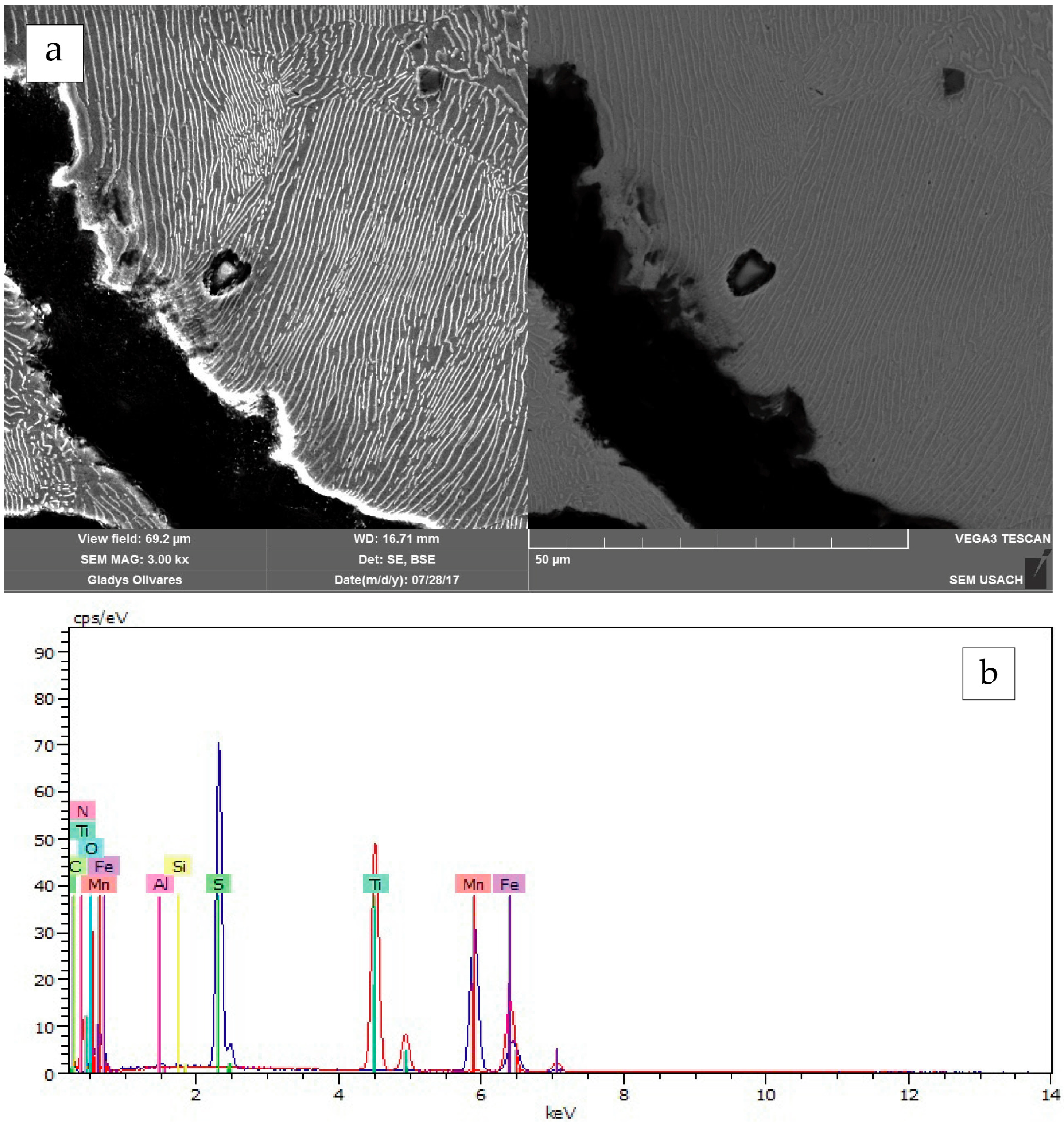
| Artefact | Dimensions (cm) | Weight (kg) | Channel Holes | Marks | Description |
|---|---|---|---|---|---|
| Ballast No. 1 | 59 × 14 × 14 | 72 | Double | - | Single ballast block. Diagonal channel holes on each end. Shingle ballast stones, fibres, and wood remains recovered during the deconcretion process. |
| Ballast No. 2 | 91 × 15 × 15 | 140 | Double | - | Single ballast block. A diagonal channel hole is visible on one end, its opposite can be inferred. Abundant concreted shingle ballast stones and remains of wood were observed. |
| Ballast No. 3 1 | 46 × 11.5 × 11.5 | 60.8 | Single | - | Two ballast blocks of similar size concreted alongside, one visibly disintegrated. A diagonal channel hole is visible on one end. |
| Ballast No. 4 | 41 × 10.5 × 11 | 33.7 | Single | - | Single ballast block. A diagonal channel hole is visible on one end; the opposite side is presumably fractured. Wood remains on the inferior face, possibly dunnage. |
| Sample | Fe | C | Si | P | Mn | Al | S |
|---|---|---|---|---|---|---|---|
| No. 1 | 94.51 | 2.52 | 0.31 | 1.27 | 1.29 | n/d | 0.10 |
| No. 2 | 94.27 | 2.58 | 0.14 | 1.15 | 1.28 | 0.42 | 0.16 |
| No. 3 | 92.63 | 2.9 | 2.31 | 0.13 | 1.37 | 0.41 | 0.25 |
| No. 4 | 95.29 | 3.89 | 0.15 | 0.04 | 0.45 | <0.01 | 0.01 |
Disclaimer/Publisher’s Note: The statements, opinions and data contained in all publications are solely those of the individual author(s) and contributor(s) and not of MDPI and/or the editor(s). MDPI and/or the editor(s) disclaim responsibility for any injury to people or property resulting from any ideas, methods, instructions or products referred to in the content. |
© 2023 by the authors. Licensee MDPI, Basel, Switzerland. This article is an open access article distributed under the terms and conditions of the Creative Commons Attribution (CC BY) license (https://creativecommons.org/licenses/by/4.0/).
Share and Cite
Carabias, D.; Ciarlo, N.C.; Araya, C.; Morales, C.; Gutiérrez, F. Ballasting a Mid-19th Century Chilean Navy Armed Transport: Archaeometallurgical Insights into Cast Iron Ingots Recovered from the Barque Infatigable (1855). Heritage 2023, 6, 2126-2151. https://doi.org/10.3390/heritage6020114
Carabias D, Ciarlo NC, Araya C, Morales C, Gutiérrez F. Ballasting a Mid-19th Century Chilean Navy Armed Transport: Archaeometallurgical Insights into Cast Iron Ingots Recovered from the Barque Infatigable (1855). Heritage. 2023; 6(2):2126-2151. https://doi.org/10.3390/heritage6020114
Chicago/Turabian StyleCarabias, Diego, Nicolás C. Ciarlo, Carolina Araya, Carla Morales, and Felipe Gutiérrez. 2023. "Ballasting a Mid-19th Century Chilean Navy Armed Transport: Archaeometallurgical Insights into Cast Iron Ingots Recovered from the Barque Infatigable (1855)" Heritage 6, no. 2: 2126-2151. https://doi.org/10.3390/heritage6020114
APA StyleCarabias, D., Ciarlo, N. C., Araya, C., Morales, C., & Gutiérrez, F. (2023). Ballasting a Mid-19th Century Chilean Navy Armed Transport: Archaeometallurgical Insights into Cast Iron Ingots Recovered from the Barque Infatigable (1855). Heritage, 6(2), 2126-2151. https://doi.org/10.3390/heritage6020114








